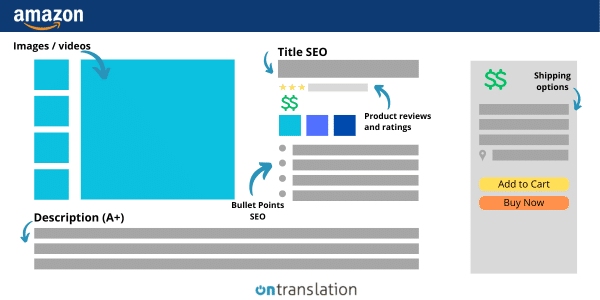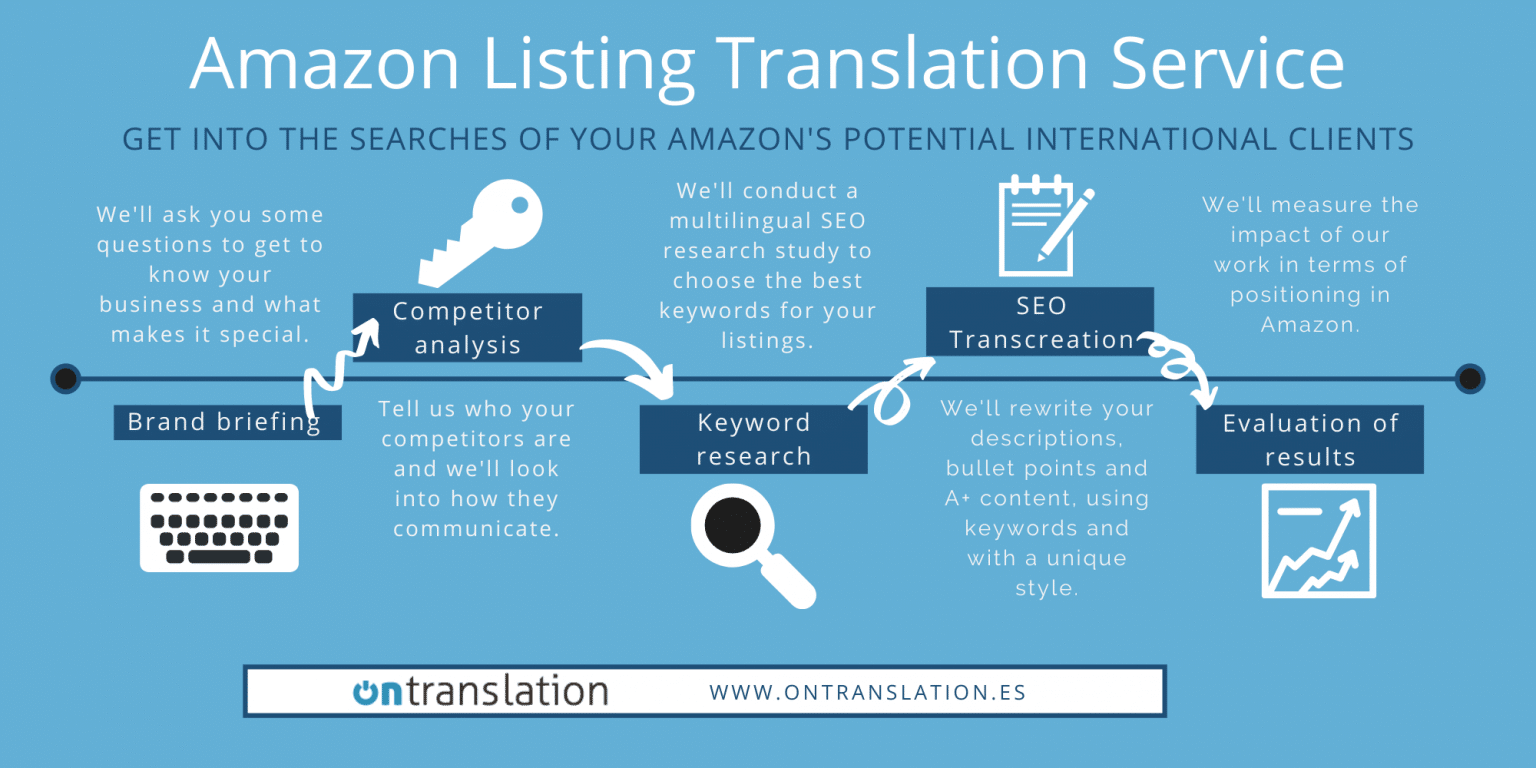Amazon is undergoing a remarkable transformation, breaking down geographical barriers to create a diverse, expansive and international platform. For sellers and vendors with eyes set on international markets, the key to unlocking this potential lies in mastering SEO localization for Amazon Listings.
SEO localization goes far beyond simple machine translation. It requires a deep dive into the cultural, linguistic, and specific market nuances that define global commerce.
Below, we explore the intricate world of SEO localization. We will highlight the critical importance of intercultural communication, by offering insights into how to tailor your bullet points and product images for a variety of international audiences.
Why Intercultural Communication is Your Ally
Intercultural communication plays a pivotal role in SEO localization by bridging the gap between different cultures. It’s not just about translating text. It’s about conveying the intended message in a way that is culturally relevant and resonant with the target audience.
For Amazon listings, this means not only adapting language but also ensuring that your message (titles, bullet points, A+ content, images, etc.) aligns with local expectations and preferences.
Moreover, understanding local consumer behavior is crucial for optimizing Amazon listings. This includes preferences for product types, brand perceptions, and purchasing habits.
For example, markets that place a high value on sustainability may respond better to products that emphasize eco-friendly features.
Moments of Use Analysis
At this point, a Moments of Use analysis would take your listing localization strategy to the next level.
This analysis delves into the practical and emotional contexts in which your product is used by consumers in the target market.
Incorporating a Moments of Use analysis into your SEO localization strategy for Amazon listings provides a multi-dimensional understanding of how your product fits into the lives of your target audience.
It also allows you to craft bullet points and other content that speak directly to when, why, and how your product will be used. In doing so, you’ll create a deeper connection with potential customers.
A Moments of Use analysis answers critical questions such as:
When and how is the product used?
Understanding the specific scenarios in which your product will be utilized can reveal cultural nuances that affect its appeal.
For example, a product used primarily for outdoor activities may need to highlight different features in a market where outdoor spaces are a significant part of the culture.
What emotional or practical needs does the product fulfill?
By identifying the emotional resonance or practical utility of your product in a cultural context, you can tailor your messaging to emphasize these aspects.
This could involve highlighting convenience and efficiency in cultures that value saving time, or focusing on communal enjoyment in societies that prioritize family and group activities.
How can your product be a part of local traditions or routines?
Integrating your product into the fabric of local traditions or daily routines can enhance its relevance and appeal. This might involve positioning your product as essential for a particular festival, holiday, or social practice.
Bullet Points: Adapting to Cultural Priorities
When localizing Amazon listings from one market to another, you may need to reorganize the order of bullet points.
The importance of product features and benefits can vary significantly across cultures. Thus, you should reorganize your bullet points to align with local priorities and consumer interests.
In some cultures, technical specifications might be more important than the product’s aesthetic appeal. Therefore, you’ll necessitate a change in the order of bullet points to highlight this information first.
Conversely, you should prioritize aesthetic appeal or product backstory (e.g., artisanal craftsmanship) in markets where these aspects hold more value for customers.
You should also consider including important cultural symbols, meanings or references into the structure of your bullet points. For example, If a product feature is particularly beneficial during a local holiday or cultural event, this feature should be highlighted accordingly in markets where the event is celebrated.
To navigate these cultural nuances effectively, incorporating the expertise of ICA: Intercultural Communication Assistant GPT can be a game-changer for your global SEO strategy on Amazon.
Whether it’s deciding which product features to highlight first or how to incorporate cultural symbols meaningfully, ICA provides a nuanced understanding of cross-cultural communication that can enhance your Amazon listing’s appeal to a global audience.
Visual Localization in Amazon Listings
Visual localization of product images involves meticulous consideration of elements like color symbolism and imagery composition to ensure they align with local expectations and avoid cultural misinterpretations.
By embedding products within contexts that mirror the target audience’s culture and lifestyle, visual localization significantly bolsters the trust and relevance of Amazon listings cross-borders.
This strategic alignment not only heightens the brand’s appeal but also cements its credibility among new market segments.
Cultivating trust through culturally resonant imagery is instrumental in building a robust, loyal customer base across diverse geographical landscapes. It’ll help to showcase the brand’s commitment to understanding and valuing its international clientele.
Moreover, localizing visuals directly impacts conversion rates, as customers are more inclined to engage with products that reflect their own experiences and environments. This familiarity breeds a stronger product connection, thereby increasing sales.
Together, these elements not only clarify product utility for an international audience but also drive customer satisfaction and loyalty, marking visual localization as a cornerstone of successful global expansion on Amazon.
SEO Localization in a Nutshell
SEO localization is the linchpin of Amazon cross-borders expansion, where intercultural communication is . It blends localization, copywriting and SEO optimization to make your products discoverable and appealing worldwide.
This high-value-added process is about crafting your listings to mirror local search behaviors, cultural contexts, and linguistic idiosyncrasies to ensure your products resonate with international customers at every touchpoint.
Understanding Values and USPs
A client brief serves as a critical starting point for any SEO localization project. It’s during this phase that the localization team gains a profound understanding of the company’s core values and the unique selling points (USPs) of its products.
But why is this understanding so vital?
Alignment with Market Expectations
Each market has its unique cultural nuances, preferences, and expectations. By understanding the core values and USPs of a product, the localization team can tailor the Amazon listing to align with these market-specific characteristics.
This alignment is essential for resonating with the target audience and making the product relevant and appealing to them.
Differentiation in a Crowded Marketplace
The digital marketplace is crowded, with countless products vying for attention. The USPs of a product are what set it apart from the competition.
In the context of global markets, these selling points may need to be presented differently to highlight their relevance and appeal in each specific cultural context.
A thorough client brief ensures that these USPs are not just translated, but effectively localized to maintain their unique value proposition across different markets.
Building Brand Consistency
While the way a brand communicates its values and USPs may change from one market to another, it’s mandatory to maintain a consistent brand image globally.
We need to understand the essence of the brand, ensuring that all localized content supports and reinforces this global brand identity, even when adapted for local markets.
Learning from the Market
Conducting a comprehensive competitor analysis is the next step for successful SEO localization for Amazon. This involves reverse-engineering the keywords, tone, and style of competitors in your target market.
Such data will help you assess whether competitors are local businesses or other international players adapting their communication.
Understanding the competitive landscape enables you to craft a localization strategy that makes your listings stand out, ensuring they are culturally relevant and competitively positioned.
This insight into both local and global competitors informs your approach to localization, from keyword optimization to cultural adaptation.
A Cultural Deep Dive
The choice of keywords in one market may not carry the same meaning or relevance in another due to cultural differences. For instance, colloquial terms or phrases popular in one culture may be unknown or even inappropriate in another.
Effective search terms vary significantly from one culture to another. Thus, native keyword research for international markets demands a fresh perspective.
This process involves more than translation; it’s about understanding the local lexicon, search habits, and cultural nuances that influence how consumers find products online.
Conducting keyword research from scratch for each target market ensures that your listings are optimized for local relevance and searchability. In doing so, you’ll make your products visible to the right audience at the right time.
Beyond Translation and Localization
At the heart of SEO localization lies transcreation—the art of creatively adapting your message to maintain its intent, style, tone, and context across different languages and cultures.
This combination of localization and copywriting ensures that your product listings are understood, compelling, and persuasive to international customers.
Proper SEO transcreation would boost your listings engagement with global audiences on an emotional level thanks to the addition of relevant keywords your target market would use to find your product.
Mastering Global Markets with SEO Localization
Intercultural communication is crucial in the world of global ecommerce. It serves as a bridge that connects your brand with diverse markets through the power of SEO localization.
This strategy goes beyond simple translation, diving deep into the cultural nuances of each target audience to ensure your Amazon listings engage on a deeper level.
By integrating local consumer behaviors, preferences, and cultural symbols into your product imagery and content, SEO localization amplifies your brand’s relevance fostering trust and connection.
This commitment to cultural sensitivity distinguishes your listings and elevates your brand’s global appeal. Ready to go global with your Amazon brand?Let’s make your products not just seen, but purchased over and over again.
Author
Oscar Nogueras is CEO at Ontranslation, a multilingual communication and translation company based in Barcelona, specializing in digital marketing and cross-border e-commerce. Oscar’s been working in the translation industry for more than 20 years, and is also a lecturer of PPC and SEO Localization.







